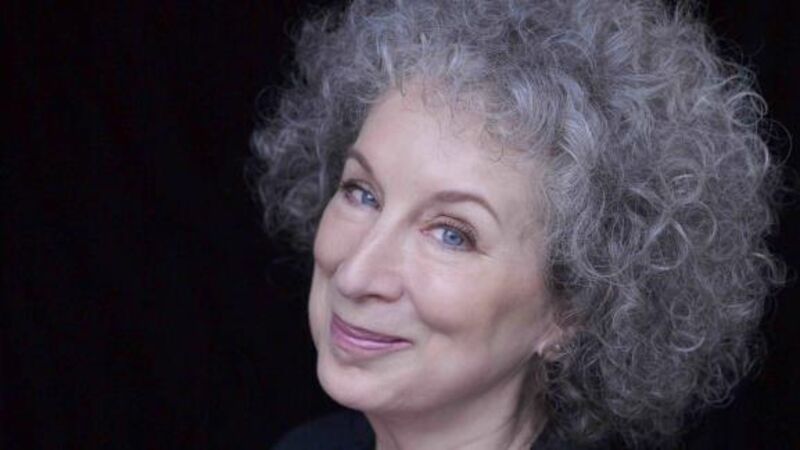It’s a mad, mad, world

“It was very lovely,” she says. “The Gaelic name for the place was ‘smelly beach’. It was near Skibbereen. It was called ‘smelly beach’ because, once upon a time, there was a war or a fight there and they threw the bodies into the narrow bay.
“They washed out, and then they washed in again; then they washed out again, then they washed in again. After it happened a few times, it was very smelly.
“I had to receive the galley proofs of Alias Grace there. I remember, there was going to be a courier delivering them, but we didn’t have any house number. It was out in the country, so we had to hang out a tea towel to mark which house we were in.”
The embattled rump of human survivors left in her new novel, MaddAddam, the third and final instalment of her post-apocalyptic trilogy, would have appreciated the gumption of the tea towel. Needs must in a world decimated by plague, and where giant, genetically modified pigs, among other predators, roam its jungle terrain.
MaddAddam, which follows Oryx and Crake (2003), and Atwood’s last novel, The Year of the Flood (2009), is speculative fiction rather than science fiction.
There are no aliens and no time-travelling. All its gizmos and beings exist, or are possible in theory. The novel hinges on an examination of what might happen if the human race takes all the wrong turns. The Crakers are its most interesting inhabitants. They were hatched by Crake to overcome mankind’s problems. Crake thought he could perfect humanity.
The Crakers eat leaves, so they don’t need agriculture. They have in-built sunblock and insect repellent, and they’re shoed with an extra layer of skin on their feet, so they’re not dependent on cotton-growing or the fashion industry.
They’re also devoid of sexual jealousy.
“They’ll never suffer from romantic agony, because, like most mammals and unlike us, they mate seasonally, with clear colour-coded indications of when those times are, and they also, like cats, mate in groups, so there will never be any fisticuffs over who’s really the dad,” says Atwood.
“They don’t care. Added to that, you’ll never get rejected for a Saturday-night date, because either the person will not be in season or you’re just as eligible as everybody else.
“Crake solved those problems. He also tried to get rid of music, but that didn’t work, so music stays.
“He would have liked to have gotten rid of symbolism, because it leads to religion, but he didn’t manage to do that either, as it turns out.
“There are some human things that stay. He certainly didn’t get rid of the narrative form, because Crakers are very keen on hearing stories, and especially stories about themselves, as we all are.
“If you look at what human beings do when they’re under the age of four, that’s probably our toolkit that we come with. Little children understand stories as early as one.
“They get it that the moo-cow has met the chicken and that one of them has fallen into the pond, and that this has happened and that has happened, and now we’re going to turn the page and ‘what happens here?’ Something else. That is what narrative is.
“We probably found it a great advantage, through the ages, to use stories to instruct: ‘don’t go into the river there, uncle George got eaten by a crocodile there, with great, big teeth. We don’t want that to happen to you.’ ‘Here’s how we hunted the gazelle, which is why we’re having this delicious gazelle right now for dinner.’
“Not only that, ‘we are the people with the red-ochre circle on the top of our heads. We, all in this group, belong to this particular tribe.’ We use stories for social cohesion. We also, almost universally, do ‘where did we come from?’ stories.”
Atwood knows about the world. In conversation, and the array of ideas explored in her dystopian trilogy, she flits easily from the light-hearted to the weighty, from philosophical discussions about pornography in Japan, and the blood feuds of the ancient Greeks, to why Margaret Thatcher was a queen bee surrounded by drones.
Her appreciation of science and the world’s creatures springs from her upbringing.
Atwood was born in Ottawa, in 1939. Her mother was a nutritionist, her father a zoologist.
Half of Atwood’s childhood days were spent in the wilds of northern Quebec, while her father worked on field trips.
Atwood knew early on what her calling would be. An entry in a high-school yearbook listed her intention to write the great Canadian novel. Atwood didn’t disappoint. She’s been shortlisted for the Booker Prize five times, scooping the award in 2000 for The Blind Assassin, although The Handmaid’s Tale, another dystopian novel, from 1985, is widely regarded as her finest book, among a canon of 30 published works.
Atwood came to prominence as a poet, and knocked about with Leonard Cohen in Montreal poetry circles, when she lived in the city in the mid-1960s. Her abiding impression of Cohen is that he was a gentleman.
“I remember listening to him, on a radio programme, a little while ago, and the announcer said, ‘Leonard, Leonard, your voice, your voice — you used to have much more range. Now, it’s gone to the lower range’. Leonard said (Atwood, scrapes her voice along the gravel) ‘It’s the cigarettes’.”
* Margaret Atwood is at the Mountains to Sea book festival, tomorrow at 8.30pm at the Pavilion Theatre, Marine Rd, Dún Laoghaire, Co Dublin. For more: www.mountainstosea.ie.











